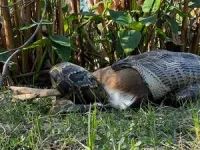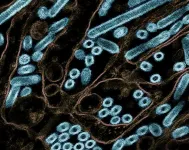(Press-News.org) Burmese pythons can consume prey even larger than scientists realized, according to a new study.
That means more animals are on the menu across southern Florida, where the nonnative, invasive snakes have decimated populations of foxes, bobcats, raccoons and other animals.
Pythons swallow deer, alligators and other prey whole. What they eat is limited in part by how big an animal they can wrap their flexible, stretchy jaws around. Researchers call this the snake’s gape.
University of Cincinnati Professor Bruce Jayne said measurements of snakes captured in and around Everglades National Park show that the biggest pythons have an even bigger gape than mathematical models would suggest.
Jayne examined three of the largest snakes captured by research partners Ian Easterling and Ian Bartoszek at the Conservancy of Southwest Florida measuring 15, 17 and 19 feet long.
Researchers previously examined pythons with a gape of 22 centimeters (or 8.7 inches) in diameter. But the largest of the snakes Jayne’s research partners captured had a maximal gape of 26 centimeters (or 10.2 inches).
“That doesn’t sound like a lot — just 18% bigger,” Jayne said.
But the total area of the gape increased by a whopping 40%, Jayne said. The largest snakes had a gape circumference of more than 81 centimeters — the equivalent of a 32-inch waist on a pair of pants.
And that means snakes can consume far larger prey than was previously known. Based on prey items researchers found inside Burmese pythons, researchers know they will kill and consume animals nearly too big to swallow. Researchers observed one snake consuming a 77 pound deer representing two-thirds of the snake’s total mass.
“Watching an invasive apex predator swallow a full-sized deer in front of you is something that you will never forget,” Bartoszek said.”The impact the Burmese python is having on native wildlife cannot be denied. This is a wildlife issue of our time for the Greater Everglades ecosystem.”
Knowing the limits on the size of prey that predators can eat can help researchers predict the ecological impact the invasive snakes might have as they move into new areas.
The study was published in the journal Reptiles & Amphibians.
Burmese pythons are native to the rainforests of southeast Asia. They were introduced to the wilds of Florida through the pet trade as escapees and intentional releases from irresponsible owners.
What gives pythons the ability to eat such large animals is their incredible mouths. The lower jawbone is not fused at the front allowing the jaws to stretch wide. And their skin is so soft and super stretchy that it accounts for more than half the circumference of their gape, allowing the pythons to consume prey six times bigger than that of other similar-sized snake species.
Researchers examined the scaling relationship between the snake’s gape and its cranial anatomy and overall size to understand its predatory capabilities.
Burmese pythons are about 24 inches long and weigh about 4 ounces when they hatch, but they grow fast. They can double their length and body weight in a year. The biggest adults can stretch nearly 20 feet and weigh more than 200 pounds.
“Big pythons longer than 16 feet are very rare. Of the more than 9,000 pythons that contractors have captured in Florida, less than 1% were of that extreme size,” Jayne said.
The Conservancy of Southwest Florida began its Burmese python research and removal efforts in southern Florida in 2013.
The group tracked the movements of 120 radio-tagged adult pythons known as “scout snakes” to better understand the invasive population. Its primary objective is to create a database of behavior and habitat use to better understand python activity. This research helps to inform policymakers, biologists and land managers to develop better control strategies for the invasive snakes.
Bartoszek and his team have removed 770 pythons, collectively weighing more than 33,000 pounds, that are large enough at 6.5 feet or more to eat an animal at least the size of a baby deer. If each of these snakes were to consume just one deer as big as they could swallow, Jayne estimates that would represent a staggering 13,000 pounds of prey.
Jayne said this enormous capacity to eat prey is a big concern if pythons spread to other parts of Florida and potentially the rest of the American Southeast. Burmese pythons are showing up in more places across Florida.
“That’s the tip of the iceberg of this phenomenal impact on prey populations in Florida,” he said. “Researchers are trying to get a handle on where the spread might stop.”
END
Pythons can swallow even bigger prey than scientists realized
Findings help explain risk to wildlife from nonnative, invasive snakes
2024-10-28
ELSE PRESS RELEASES FROM THIS DATE:
Evidence mounts for dark energy from black holes
2024-10-28
Image
Almost 14 billion years ago, at the very beginning of the Big Bang, a mysterious energy drove an exponential expansion of the infant universe and produced all known matter, according to the prevailing inflationary universe theory.
That ancient energy shared key features of the current universe's dark energy, which is the largest mystery of our time by at least one objective standard: It makes up the majority—roughly 70%—of the universe, but scientists ...
AI might scare us, but can we scare it?
2024-10-28
In recent years, advancements in artificial intelligence have enabled intelligent machines to generate visual art, compose music, and create videos. They converse with us, help with homework, and have even begun competing for our jobs. Amid these advances, machines evoke powerful reactions from humans—sparking concerns about control, fairness, and the potential for misuse. Many feel unsettled by the growing presence of intelligent machines when they inadvertently reinforce power imbalances and perpetuate injustices.
Amid all of this disruption and mistrust, we are comforted to know that machines can`t have emotions. Yet, recent advancements in language-based AI have demonstrated ...
Early intervention in patients with asymptomatic severe aortic stenosis and myocardial fibrosis
2024-10-28
About The Study: In asymptomatic patients with severe aortic stenosis and myocardial fibrosis, early aortic valve intervention had no demonstrable effect on all-cause death or unplanned aortic stenosis–related hospitalization. The trial had a wide 95% CI around the primary end point, with further research needed to confirm these findings.
Corresponding Author: To contact the corresponding author, Marc R. Dweck, PhD, email marc.dweck@ed.ac.uk.
To access the embargoed study: Visit our For ...
Rutgers receives $3.3 million federal grant to recruit counselors for high-need schools
2024-10-28
Rutgers University’s Graduate School of Education (GSE) has received a $3.3 million grant to increase the number and diversity of highly trained school counselors to help fill the gap in mental health services in New Jersey high-need school districts.
The Mental Health Service Professional Demonstration grant from the U.S. Department of Education – part of a federal initiative to expand nationwide student access to school-based mental health services – will fund the GSE-led School Counseling Prevention to Intervention project.
“School counseling is often a misunderstood and under-resourced profession,” said Ian Levy, an assistant professor of school counseling ...
Bovine H5N1 influenza from infected worker transmissible and lethal in animal models
2024-10-28
WHAT:
A highly pathogenic avian influenza (HPAI) H5N1 virus, isolated from the eye of a farm worker who became infected through contact with dairy cows, was lethal in mice and ferrets infected in a high-containment laboratory environment, according to a new study in Nature. The study investigators also found that the virus isolated from the worker, who experienced mild inflammation of the cornea (conjunctivitis), could be transmitted through the air between separated ferrets and might be capable of binding to and replicating in human respiratory tract cells.
The virus isolated from the worker is called huTX37-H5N1 and has a mutation (PB2-E627K) frequently seen in avian influenza viruses ...
Marzougui & Kan receive funding for crash testing
2024-10-28
Dhafer Marzougui, Associate Professor, Physics and Astronomy, College of Science, and Cing-Dao Kan, Professor/Director, Center for Collision Safety and Analysis, College of Science, received funding for: “NCHRP Project 03-110-01.”
Marzougui and Kan aim to identify and evaluate the crash performance of breakaway sign and luminaire supports and crashworthy work-zone traffic control devices that are non-proprietary and commonly used.
The researchers will examine in-service safety performance, potential failure modes (and, if possible, design modifications that might address ...
Global leaders in the fight against cancer gathered in Washington, DC on October 18, 2024, for the NFCR Global Summit and Award Ceremonies for Cancer Research & Entrepreneurship
2024-10-28
Washington, DC – The 2024 National Foundation for Cancer Research (NFCR) Global Summit and Award Ceremonies for Cancer Research & Entrepreneurship, co-hosted with the AIM-HI Accelerator Fund, convened the world’s top experts across cancer research, biotech entrepreneurship, pharmaceuticals, investment, and patient advocacy. This prestigious event, held at the National Press Club, served as a unique forum for advancing groundbreaking science, fostering innovative collaborations, identifying ...
New research highlights economic and employment challenges for parents of medically complex babies
2024-10-28
Parents with babies born preterm or with low birth weight face significant economic and employment challenges, according to new research published in JAMA Pediatrics.
The study, led by Erin Von Klein, MD, a neonatology fellow at Monroe Carell Jr. Children’s Hospital at Vanderbilt, reveals that 30% of parents with a very low birth weight baby (under 1,500 grams or 3.3 pounds) have had to make an employment decision based on their child’s health and the required ongoing care after discharge from the neonatal intensive care unit.
"The lower the child's birth weight, the more likely a parent was to make one of these decisions," said Von Klein. "Of parents with ...
Prenatal cannabis exposure and executive function and aggressive behavior at age 5
2024-10-28
About The Study: Results from this contemporary U.S. cohort where prenatal cannabis exposure was common and indicated that exposed children exhibited some differences in aspects of executive function and behavior relevant to long-term academic success and adaptive functioning. These results may be considered in refining clinical recommendations regarding cannabis use during pregnancy.
Corresponding Author: To contact the corresponding author, Sarah A. Keim, PhD, email sarah.keim@nationwidechildrens.org.
To ...
BMI and postacute sequelae of SARS-CoV-2 infection in children and young adults
2024-10-28
About The Study: In this cohort study, elevated body mass index (BMI) was associated with a significantly increased post-acute sequelae of SARS-CoV-2 infection risk in a dose-dependent manner, highlighting the need for targeted care to prevent chronic conditions in at-risk children and young adults.
Corresponding Author: To contact the corresponding author, Yong Chen, PhD, email ychen123@pennmedicine.upenn.edu.
To access the embargoed study: Visit our For The Media website at this link ...
LAST 30 PRESS RELEASES:
Heart-brain connection: international study reveals the role of the vagus nerve in keeping the heart young
Researchers identify Rb1 as a predictive biomarker for a new therapeutic strategy in some breast cancers
Survey reveals ethical gaps slowing AI adoption in pediatric surgery
Stimulant ADHD medications work differently than thought
AI overestimates how smart people are, according to HSE economists
HSE researchers create genome-wide map of quadruplexes
Scientists boost cell "powerhouses" to burn more calories
Automatic label checking: The missing step in making reliable medical AI
Low daily alcohol intake linked to 50% heightened mouth cancer risk in India
American Meteorological Society announces Rick Spinrad as 2026 President-Elect
Biomass-based carbon capture spotlighted in newly released global climate webinar recording
Illuminating invisible nano pollutants: advanced bioimaging tracks the full journey of emerging nanoscale contaminants in living systems
How does age affect recovery from spinal cord injury?
Novel AI tool offers prognosis for patients with head and neck cancer
Fathers’ microplastic exposure tied to their children’s metabolic problems
Research validates laboratory model for studying high-grade serous ovarian cancer
SIR 2026 delivers transformative breakthroughs in minimally invasive medicine to improve patient care
Stem Cell Reports most downloaded papers of 2025 highlight the breadth and impact of stem cell research
Oxford-led study estimates NHS spends around 3% of its primary and secondary care budget on the health impacts of heat and cold in England
A researcher’s long quest leads to a smart composite breakthrough
Urban wild bees act as “microbial sensors” of city health.
New study finds where you live affects recovery after a hip fracture
Forecasting the impact of fully automated vehicle adoption on US road traffic injuries
Alcohol-related hospitalizations from 2016 to 2022
Semaglutide and hospitalizations in patients with obesity and established cardiovascular disease
Researchers ‘listen in’ to embryo-mother interactions during implantation using a culture system replicating the womb lining
How changing your diet could help save the world
How to make AI truly scalable and reliable for real-time traffic assignment?
Beyond fragmented markets: A new framework for efficient and stable ride-pooling
Can shape priors make road perception more reliable for autonomous driving?
[Press-News.org] Pythons can swallow even bigger prey than scientists realizedFindings help explain risk to wildlife from nonnative, invasive snakes




